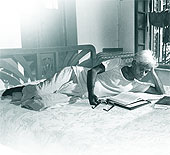 |
This was the early 1950s; a young man had just completed his masters in physics with flying colours. Inspired by his father, a school teacher who often had to fight hard for recognition, he was drawn to an academic career. A hard choice those days, with limited options. But physics, theoretical and mathematical, beckoned irresistibly. Even so, within the discipline of physics it wasn’t the raging fashion of the days ? nuclear physics ? but something many at that time felt was archaic, namely, Albert Einstein’s general theory of relativity (GTR). Once christened the ‘greatest feat of human thought’, GTR at 40, it seemed, had passed its prime. And now its wrinkled charm enchanted only diehard believers ? and perhaps a solitary, unguided, rather independent-minded, 20-something, hard-pressed for survival in academics.
Prof. Amal Kumar Raychaudhuri, who died on June 18 at the age of 81, had had a couple of false starts in research, the first in theoretical physics at the Presidency College, the second in experimental physics at the Indian Association for the Cultivation of Science (IACS), and was not exactly brimming with self-confidence. As a temporary lecturer at the Asutosh College, it was either make or break. But dogged he was, as a young researcher. And a paper by Einstein himself provided the impetus in a strange way.
Einstein had startled the world in 1915 by declaring through the equation of GTR that spacetime, like matter and radiation, is not static, but must evolve. Far from being an inert backdrop for things happening in the Universe (as human erudition of all earlier generations had assumed), spacetime participates in every possible action of matter and radiation on an equal footing. The curved geometry of spacetime is everchanging, dancing in unison with energy and momentum density of matter, and of radiation. In its turn, the geometry of spacetime guides matter and radiation along curved paths. It is a symbiotic relationship.
Following up the geometrical ideas of the great 19th-century mathematician Bernhardt Riemann, Einstein had thought of spacetime as being a ‘smooth continuum’ of events, its curvature everywhere (and ‘everywhen’) finite. This smoothness of spacetime is supposed to remain throughout its evolution under various circumstances.
If so, can spacetime ever have a beginning or an end ? If it does, won’t either of these events be quite special, ‘singular’ so to speak, so as to be in conflict with the idea of a smooth continuum? These thoughts must have tormented the master. For he must have envisioned in such catastrophic events the breakdown of his marvellous theoretical edifice ? the GTR.
Martin Schwarzschild, in 1916, had derived a beautiful spherically symmetric solution to Einstein’s seminal equation, corresponding to the spacetime due to a point mass as the source of curvature. Einstein regarded this solution as a landmark achievement. The spacetime depicted in this solution appeared at first to be quite smooth. Later, however, it was felt that this spacetime has not one, but two regions where the geometry appears to deviate from smoothness. One is at the very location of the point mass. The second is a spherical surface enshrouding the point mass, which behaves like a one-way membrane. While things may fall through this membrane and reach the location of the mass, nothing, not even light, can cross it in the other direction and get out. In the early 1950s, this ‘event horizon’ (as it was called) was thought to be a ‘singular’ set of events, and was occasionally referred to as the ‘Schwarzschild singularity’. Einstein was particularly bothered by this ‘singularity’, and concocted a rather imaginative model to argue, “beyond reasonable doubt,” that no material particle could ever approach the ‘Schwarzschild singularity’.
But what of the young Raychaudhuri, who, as he himself wrote, was possessed with an ‘unreasonable’ doubt? To him, the master’s assay on the ‘Schwarzschild singularity’ appeared rather inadequate. On the one hand, it seemed more to be a matter of a bad choice of reference frame, rather than a real catastrophe. On the other hand, Raychaudhuri could show that the other singularity in the Schwarzschild solution, the one at the location of the point mass, is by no means as innocuous. Spacetime there is just the opposite of something smooth. In fact, it ends catastrophically, with the curvature growing to infinitely large values.
This is not a situation which general relativity can handle, and is called a spacetime singularity. (We now know that this singularity is the inevitable fate of all massive stars that undergo gravitational collapse after their death ? it characterises the ‘hole’ of the consequent black hole.) Not a conclusion that the master would have loved, but the result of spectacular courage and great maturity from a young person fighting hard for survival. Never in the history of Asutosh College has a better paper been written in physics, till date. And yet his job at the college was not a permanent one.
Raychaudhuri was of course fortunate to get another temporary appointment, this time as a research officer at the IACS, at the end of his term at Asutosh College. His attention turned to the Big Bang Theory ? of the Universe having started with a cataclysmic explosion. This ‘bang’ also characterises the beginning of spacetime itself, and is thus a spacetime singularity; but one having to do with the beginning, rather than with the end, as in the Schwarzschild case.
To obtain the Big Bang, one needed to extrapolate the well-known expanding spacetime solution backwards in time, over billions of years. Expanding spacetimes, of course, emerge when one appeals to the Cosmological Principle, according to which, space looks the same in all directions and is uniform.
Raychaudhuri now started to ponder whether spacetime singularities appear in the theory because of the special symmetries one assumes for simplicity for the solutions. Or do they appear because they are a fairly common and generic feature of GTR itself?
Deep points to ponder, but under heavy duress, because, meanwhile, his tenure at the IACS had been made permanent only under the condition that he worked on problems “approved by the director and the head of the department”. And the authorities felt general GTR was archaic.
 |
 |
| stroke of genius: The Raychaudhuri equation became a key tool in the hands of Stephen Hawking and Roger Penrose (above) |
But that could hardly deter the defiant young man who realised that he was on to a very important problem. He had to find a very general approach, one which did not depend on simplifying symmetries of special solutions of the Einstein equation. It had to be quintessentially geometrical. It was a great challenge, to surpass the master, as it were, especially for one who had hardly received any formal training as a general relativist. The going was inordinately tough. But the tough one got going.
Raychaudhuri began with a study of neighbouring paths of free particles and light rays in a very general curved spacetime, without assuming that such a spacetime emerged from the Einstein equation. Do these paths converge together, or do they diverge away from one another? Convergence would imply, a bit indirectly perhaps, the existence of a genuine spacetime singularity. Divergence, in contrast, would enable particles to avoid the spikyness of spacetime.
The answer emerged through a wonderful equation ? the now-famous Raychaudhuri equation ? which provides the most general geometrical criteria for convergence or divergence of paths (geodesics) in a general curved spacetime. If the spacetime happens to be a solution of the Einstein equation (with reasonable ‘energy conditions’), the paths appear destined to converge.
For the first time, singularities seemed inevitable in GTR, and could no longer be argued away as being artifacts of special properties of specific solutions of the Einstein equation. Again, not a result the master would have rejoiced over.
When his paper, containing a full derivation of his grand equation, finally saw the light of day in 1955, Raychaudhuri was convinced that he had done something significant. Stalwarts of Indian physics, though, at the time remained strangely sceptical. And recognition within India was not forthcoming.
But adulation from abroad started trickling in. First the news that his paper had been discussed and praised at a seminar led by Pascual Jordan, one of the later pioneers of relativistic quantum mechanics, reached Raychaudhuri. Then, references to the paper by experts in general relativity became known. The great originality of the work was beginning to be realised.
Finally, when it became known that the famous Soviet physicist Lev Landau had independently derived the same equation slightly later than Raychaudhuri, the international relativity community accepted it as a key contribution.
Meanwhile, Raychaudhuri had managed, in a bid to avoid professional persecution, to publish a small note in condensed matter physics ? a very different sub-discipline of physics. In this note, he extended some work of Coulson’s on pure metals, to the case of alloys ? an effort praised by Coulson himself. This, and his work on the Raychaudhuri equation (which, still, not many in India really appreciated) somehow projected Raychaudhuri as an up-and-coming physicist, and provided him with a much-needed breathing space at the IACS. He submitted a thesis based on his work on the Raychaudhuri equation for a DSc in physics, and in 1959 was awarded the degree on the glowing recommendation of none other than John Archibald Wheeler.
Despite this, an application for a promotion to a higher position at the IACS was turned down by the authorities on some flimsy pretext. Raychaudhuri felt that he had to quit the institution a second time and seek greener pastures, now that he was married with children.
A stroke of fortune in 1961 resulted in the offer of a professorship at the Presidency College, that great institution of learning from days of yore, and also his alma mater. He was now free to follow his own fancies in research. This also marked the beginning of a long and illustrious teaching career at the college. AKR (as he was popularly known) was an exceptional teacher, revered by generations of physics students at the college.
The Raychaudhuri equation hit the pinnacle of fame as it became the key tool in the hands of young relativists like Stephen Hawking and Roger Penrose in the middle and late 1960s, in their proofs of rigorous mathematical theorems on the existence of spacetime singularities. The generality of these theorems inherits the generality of the Raychaudhuri equation which is used to fashion their demonstration.
Such is the wide applicability of this great equation that like other great equations of physics ? the Schroedinger equation, Dirac equation or indeed the Einstein equation ? nobody bothers anymore about its original place or year of publication. For its essentially geometrical nature it is applied in arenas far afield than its creator could have ever imagined ? the hallmark of a truly great work. It has found permanent place in all respectable textbooks on general relativity and relativistic cosmology as a tool of great importance to analyse whole classes of issues. One wonders if there is any work in physics of comparable importance to have emerged from independent India.
Why did Raychaudhuri himself not arrive at the singularity theorems when he possessed the key tool more than a decade in advance? The answer: he was pursuing a different programme ? that of finding a spacetime free of singularities. That programme did not succeed, but careful perusal of his efforts once again bears testimony to his original approach and commitment to the subject.
It also points to the fact that Raychaudhuri always set his own research agenda, regardless of fashions of the day, or other mundane considerations, like visits abroad, awards, fellowships of academies and the like. These qualities are rare in the scientists of today. Raychaudhuri never received a job offer from a university or a research institute, even though he did apply on a few occasions.
Perhaps total commitment to academics ? research and teaching, with scant regard for material benefits ? was not the path of ‘success’. It certainly is not, in today’s milieu. Yet he was a total academic, a rarity these days. To paraphrase Einstein’s well-known remark about Mahatma Gandhi, future generations of Calcuttans will scarcely believe that such a physicist lived among us, sharing his best with so many.
(The author is a professor at the Saha Institute of Nuclear Physics)











